Sage Rountree's Blog, page 13
October 29, 2024
How to Get Better as a Yoga Teacher: Understanding Your Strengths and Blind Spots
Becoming a better yoga teacher is about more than mastering poses or memorizing sequences. It’s about knowing how to connect with your students, guiding them toward their own growth, and recognizing your own blind spots as a teacher. One of the most surprising things I’ve learned over 20+ years of teaching is that the very strengths that make us good at yoga can also hold us back as teachers.
your strengths can become blind spotsAs yoga teachers, we’re often drawn to the practice because certain aspects of it came naturally to us. Maybe you have natural flexibility, a strong sense of balance, or an affinity for mindfulness. Those strengths might have made you fall in love with yoga, but they could also make it harder for you to teach students who don’t share the same abilities. The things that came easily to you might be the very things your students struggle with, and that can create a disconnect.
If you’ve never struggled with flexibility, it’s harder to understand what it feels like to be stiff and uncomfortable in a pose. If mindfulness practices have always clicked for you, it may be difficult to empathize with a student who feels scattered and finds it hard to settle their mind. If you were born with certain body parts that half the population doesn’t have, you will not know how yoga poses might affect those parts, and how to cue for those who do have them.
The key to becoming a better teacher is recognizing these blind spots and learning how to bridge the gap.
You’re the Best Teacher for the Student You Once Were
One way to improve your teaching is to reflect on the challenges you’ve faced in your own practice. Think back to the things you struggled with—whether it was understanding alignment, managing discomfort, or figuring out how to quiet your mind. You are best equipped to teach students who are facing those same challenges because you’ve been through it yourself.
You know what it feels like to struggle in a pose or feel unsure about a new practice. That lived experience helps you break things down and offer guidance in a way that someone who never faced those challenges simply can’t.
how to recognize your teaching blind spotsTo get better as a yoga teacher, you need to identify and address your teaching blind spots. Here are a few strategies that can help:
Listen to Your StudentsYour students are your best teachers. Pay attention to the questions they ask, the cues that seem to work for them, and the moments when they struggle. When a student doesn’t seem to understand something that you find easy, that’s a clue to one of your blind spots.
Use Your Eyes and Ears
Watch your students closely. Are they grimacing in a pose? Are they looking around the room confused? If so, it may mean your cues need to be clearer or more precise. Listening to your students’ feedback, both verbal and non-verbal, is key to improving your teaching.
Ask for Feedback
Don’t be afraid to ask your students what worked for them and what didn’t. This can be as simple as a check-in after class or a formal feedback system. Hearing directly from your students can help you spot areas for improvement that you might otherwise miss.balancing teaching strengths and weaknesses
Getting better as a yoga teacher means acknowledging your strengths and using them effectively, while also working to improve your weaknesses. Maybe you’re naturally flexible and therefore struggle with teaching beginners how to ease into poses. Or perhaps you excel at creating a calm, mindful environment but need to find ways to teach meditation to folks with active minds.
Remember, your weaknesses aren’t obstacles—they’re opportunities for growth. As you become more aware of your blind spots, you’ll be able to serve a wider range of students and guide them toward deeper connection and understanding in their practice.
turning weaknesses into strengthsHere’s the flip side: The very things that challenge you in your personal practice might become your greatest strengths as a teacher. If you’ve faced a specific challenge—whether it’s a physical limitation, an injury, or difficulty with certain aspects of yoga—that experience gives you valuable insight. You know firsthand what it feels like to struggle, and that makes you more empathetic, more patient, and more creative in finding ways to support your students.
For example, if you’ve had a knee replacement, you’ll have a better understanding of how to modify poses and offer alternatives for students with similar challenges. If you’ve struggled with staying present in meditation, you’ll know how to offer guidance to students who find mindfulness difficult.
keep growing as a teacherBecoming a better yoga teacher is the work of a lifetime. It requires a commitment to ongoing growth, learning, and continuing education. This means constantly working to expand your own practice, seeking out new knowledge, and staying open to feedback. Remember that your students are not just learning from you—you’re learning from them, too.
As you continue to grow as a teacher, you’ll deepen your ability to connect with your students, help them navigate their own challenges, and guide them toward a richer and more fulfilling practice.
an affirmationI recognize I don’t even know what I don’t know.
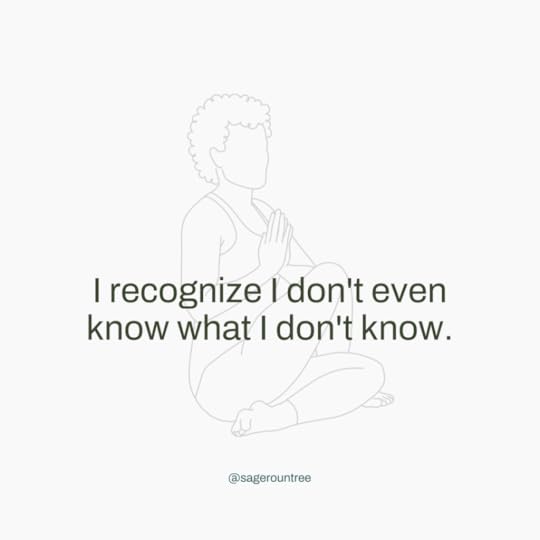
The more you understand what you don’t know, the more you’ll grow as a teacher. And the more you grow, the better you’ll be able to serve your students.
hear more about thisListen to S1E5 of Yoga Teacher Confidential, where I dive deeper into these topics.
listen to the podcastThe post How to Get Better as a Yoga Teacher: Understanding Your Strengths and Blind Spots appeared first on Sage Rountree.
October 26, 2024
Affirmation: I Greet My Students by Name
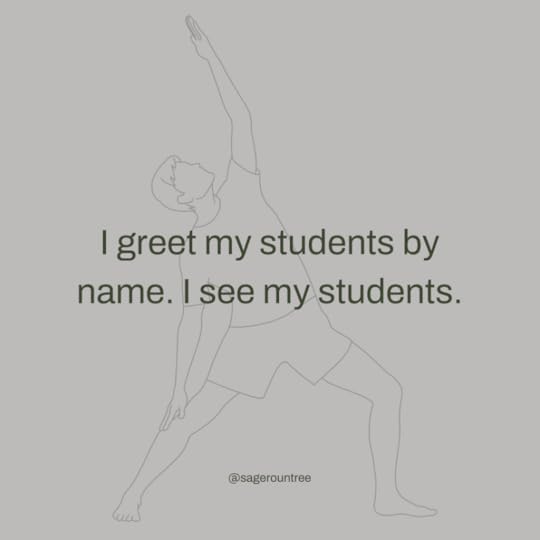
Yoga teacher affirmation: I greet my students by name. I see my students.
I acknowledge that students come to class to be seen. I show I see them by calling them by name. And I confirm I am pronouncing names correctly, so that everyone feels truly seen.
For more on this affirmation as well as practical tips on learning students’ names, listen to S1E4 of my brand-new Yoga Teacher Confidential podcast, wherever you get your podcasts or right here!
LISTEN NOWThe post appeared first on Sage Rountree.
October 22, 2024
The Importance of Learning and Using Your Students’ Names in Yoga Class
As yoga teachers, we know that our students come to class not just for the physical practice but also for the sense of connection practicing in community offers. One of the most powerful ways to foster this connection is simple: learn your students’ names and use them—correctly.
But learning names, especially when they are unfamiliar or difficult to pronounce, can feel intimidating. I get it: I’ve been teaching for over 20 years, and it’s still something I have to consciously work on. However, taking the time to learn and use your students’ names can make them feel seen and valued in a way that goes beyond any theming or cues you might offer during class. It’s a simple win that goes a very long way.
what’s in a name?Think about your own name. Have you ever had it mispronounced or called by the wrong name altogether? It’s frustrating, right? It makes you feel like the person doesn’t really know or care about who you are. When you flip that around and think about your students, you realize that getting their names right is about more than just avoiding embarrassment—it’s about making them feel welcome and seen.
When I meet new students, I’ll often ask, “Hi, are you a new face for me?” (I picked this up from my colleague and coauthor Alexandra DeSiato, an excellent communicator.) It’s an easy, friendly way to start a conversation and learn their name.
If you’ve seen the student before but can’t remember their name, simply say, “Help me remember your name” or “Can you remind me how to pronounce your name?” It’s better to ask again than to call someone by the wrong name or avoid using their name altogether.
Don’t Be Too Proud to Ask
Sometimes we get in our own heads and think, “I should know this already,” and then we feel too proud to ask. But the longer you go using the wrong name in your head, the longer that student will feel unseen by you. So get over yourself and ask! It’s an easy fix that can make all the difference in the sense of community you’re creating in your class.
For names that are unfamiliar or tricky to pronounce, I suggest using whatever tools help you remember. Maybe you write it down phonetically in your notes app, or you repeat it a few times to yourself. Or record it!
If it’s still not sticking, ask the student again after the second or third class to confirm you’re saying it properly. You’d be surprised at how appreciative people are when they see you making the effort.
should you use names during class?Using names during class is a more nuanced decision. While names can be a great tool for connection, there are times when calling out a student by name might make them feel singled out or uncomfortable—especially if it’s in the context of a correction. I recommend using names to praise or encourage students, but only if you can do so for everyone in the class, so no one feels left out.
However, don’t use names if it might create a dynamic where students are performing for your approval. Remember, your role as a teacher is to guide your students toward inner connection, not to have them performing the pose for external validation.
the power of names in building community in your yoga classWhen you greet your students by name as they come in, and again as they leave, it fosters a sense of connection that’s so important in creating a welcoming environment. “See you next week, José!” or “Hope to see you soon, Gloria!”—these simple gestures can leave a lasting impact on your students and encourage them to come back.
Using your students’ names is about more than just avoiding awkwardness—it’s about making sure that each person who steps into your class feels seen, respected, and valued for who they are.
the affirmation to rememberHere’s an affirmation to remind you of the power of names in building connection: I greet my students by name. I see my students.

Remember, when you take the time to learn and use your students’ names, you’re telling them they matter—and that’s one of the greatest gifts you can offer as a teacher.
hear moreThis is the subject of today’s episode (S1E4) of Yoga Teacher Confidential! Listen to it wherever you get your podcasts or right here:
yoga teacher confidential podcast (audio)yoga teacher confidential podcast (VIDEO)While you’re there, please leave a five-star rating and review—and on YouTube, a comment! Thanks so much.
The post appeared first on Sage Rountree.
October 19, 2024
Affirmation: It’s Not About Me

Yoga teacher affirmation: it’s not about me.
Because I center and trust my students, I understand choices they make in class—including leaving class—are not about me. I trust my students to do what is best for them.
And if you need a reminder it’s not about you:
Read my essay explaining why it’s about your students—not youListen to S1E2 of Yoga Teacher Confidential, where I talk about the reasons students walk out of class—and how to handle it when they do.The post Affirmation: It’s Not About Me appeared first on Sage Rountree.
October 17, 2024
Listen: Fit Bottomed Girls Podcast
I was delighted to go back on the Fit Bottomed Girls podcast, especially because it’s now helmed by my colleague (and Teaching Yoga to Athletes alumna!) Alison Heilig. We spoke about how to emphasize your recovery.

Happily, recovery is something you can do for completely free that will elevate every level of your life:
your moodyour athletic performanceyour relationshipsyour performance at workWatch our conversation on YouTube or listen on the Fit Bottomed Girls site.
Want to know allllll about recovery? Check out the newly released second edition of my book The Athlete’s Guide to Recovery.
The post Listen: Fit Bottomed Girls Podcast appeared first on Sage Rountree.
October 15, 2024
Now Available: Yoga Teacher Confidential Podcast
I’m thrilled to announce that my new podcast, Yoga Teacher Confidential, is officially live! This project has been a real delight to work on, and I’m so excited to finally share it with you.
listen to the podcast right nowYoga Teacher Confidential is for yoga teachers who want to feel more confident in the classroom. Whether you’ve been teaching for years or are fresh out of your 200-hour training, I’ll be sharing practical tips, honest stories, and lessons I’ve learned over my 20+ years of teaching.
What can you expect?
The first season focuses on getting you confident in front of the class room. Well start with how you can shift your mindset and approach to make your teaching more effective. Here’s what’s coming in the first few episodes—all available today:
Episode 1: You’re Not the Hero—Your Students Are
This episode is all about changing how you see your role as a teacher. When you place your students at the center of the class, everything flows better—for them and for you.
Episode 2: Don’t Apologize for Not Being Your Teacher
In this episode, I share the lesson I learned early on (just after my second-ever public class): you don’t need to apologize for being different from other teachers. Your unique style is what will resonate with your students.
Episode 3: When Students Walk Out—It’s Not About You
If you’ve ever had a student leave in the middle of class, you know how disheartening it can feel. This episode will help you understand that it’s often not about you and give you perspective to handle those situations with grace.
I hope these episodes serve you well and offer insights to support your growth as a teacher. You can listen to the podcast on all major platforms, and I’d love for you to subscribe and leave a review if you find it helpful. The first few five-star ratings and reviews are especially helpful—thanks so much!
CHoose your favorite podcast platform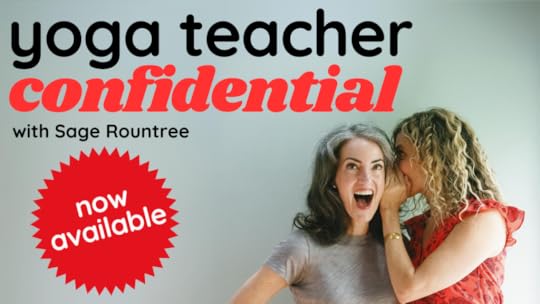
The post Now Available: Yoga Teacher Confidential Podcast appeared first on Sage Rountree.
October 12, 2024
Affirmation: I Am Not the Hero. I’m the Guide.

Yoga teacher affirmation: I center my students’ agency by recognizing that I am not the hero, I am the guide. Everything I offer is a suggestion designed to guide the hero on their journey.
For lots more on this affirmation and why it will change every element of your class and your career:
read my essay explaining this critical mindset shiftlisten to S1E1 of Yoga Teacher Confidential (launching this Tuesday!)The post Affirmation: I Am Not the Hero. I’m the Guide. appeared first on Sage Rountree.
October 8, 2024
How to Get Better at Teaching Yoga: Watch Lots of Video
Next time you’re chopping veggies or doing chores, put on a yoga video—but watch it with a teacher’s eye. Observe the sequencing, cueing, and pacing. What makes the class special? Reverse-engineer the magic to bring it into your own teaching.
Yoga teachers: pop on a yoga video next time you’re chopping videos. This isn’t for your practice; it’s for your teaching!
You can find classes with a wide range of teachers online—and you can learn something from each of them! If there is a class you especially enjoyed participating in as a student, watch it again as an observer, without participating. What makes it special? Is it the teacher’s sequencing, cueing, pacing, language? Or something else?
Reverse engineer the parts you like best to discover ways you can recreate the magic in your own classes. Here’s a favorite quote of mine: the humorist Finley Peter Dunne wrote that is the duty of newspapers to “comfort the afflicted and afflict the comfortable.” I love this idea: comfort the afflicted and afflict the comfortable. And I would apply this in a serious way to yoga teachers.
I’ve learned a lot from watching master teachers who comfort the afflicted by reassuring students when they are confused and who afflict the comfortable by challenging those who would benefit from it.
When you watch more teachers, you’ll be developing your own unique voice, so you can serve your students best!
If you want to see how I teach movement, click on over to my virtual studio! There, you’ll see both direct-to-camera classes and a vault of live classes with students present. There’s a free seven-day trial to get you started.
START YOUR TRIALlet me plan your next class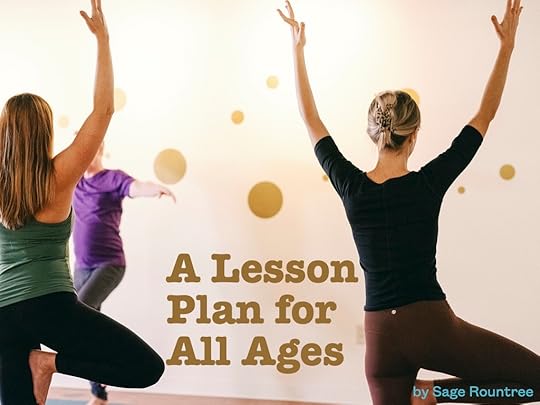
Feeling uninspired when it’s time to plan? I’m here to help!
Give me your email and I’ll send you my go-to class plan with ideas for every minute. This is the class I teach when my energy is low—but it’s the favorite of my students from 20 to 80 years old! I’ll even give you tips on how to adapt it for various class formats.
The post How to Get Better at Teaching Yoga: Watch Lots of Video appeared first on Sage Rountree.
October 5, 2024
Affirmation: I Know My Teaching Is Part of My Practice
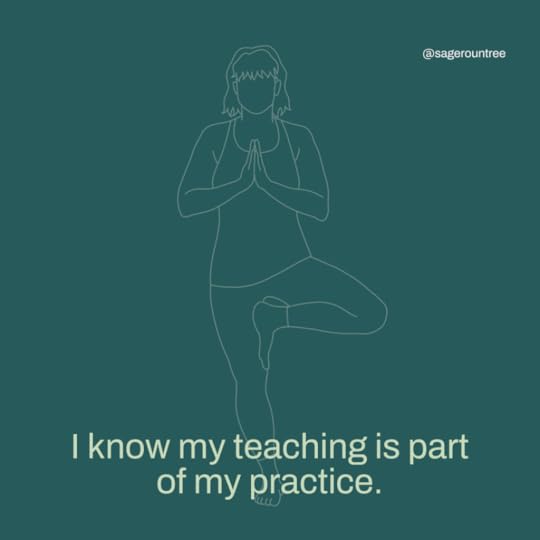
Yoga teacher affirmation: I know my teaching is part of my practice.
I learn from every class. What went well, what felt like it didn’t land—it’s all part of my growth. I recognize that teaching helps me find the right balance between effort and ease, between doing and letting.
The post Affirmation: I Know My Teaching Is Part of My Practice appeared first on Sage Rountree.
October 1, 2024
How to Get Better at Teaching Yoga: Assist Other Teachers
Want to become a better yoga teacher? Try assisting in someone else’s class. As a teaching assistant, you gain valuable insight into teaching styles, student responses, and classroom dynamics—all without the pressure of leading.
If you want to be a better yoga teacher, be a teaching assistant.
Once you are comfortable offering manual assists, or even just quiet verbal cueing and demonstrating in a large beginner class, offer to assist in a friend’s class, or your primary teacher’s class. This affords you a chance to look at what’s happening at some remove. You can observe the teacher without needing to follow their cues, which gives you insight into language, energy, tone, and pacing. You can see which cues land and which don’t. You can also observe the students both as a whole and as individuals without being in charge of the entire room at once.
Then after each class you assist, make notes as you would for your own class. List the sequence and, if relevant, the theme; detail who was in the room; note roses, thorns, and buds, or keeps, drops, and adds.
This will help fast-track your development as a teacher. And it will get you exposed to a broad range of students who will then recognize you—and eventually come take YOUR class.
let me plan your next class
Feeling uninspired when it’s time to plan? I’m here to help!
Give me your email and I’ll send you my go-to class plan with ideas for every minute. This is the class I teach when my energy is low—but it’s the favorite of my students from 20 to 80 years old! I’ll even give you tips on how to adapt it for various class formats.
The post How to Get Better at Teaching Yoga: Assist Other Teachers appeared first on Sage Rountree.



